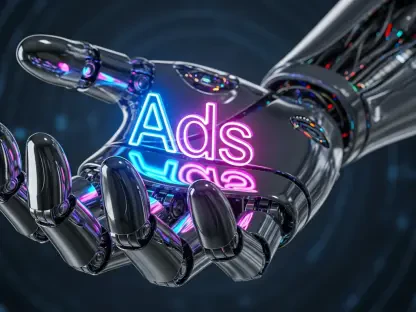Dive into the dynamic world of digital marketing and artificial intelligence with Anastasia Braitsik, a global leader in SEO, content marketing, and data analytics. With her finger on the pulse of emerging trends, Anastasia offers unparalleled insights into how generative AI is revolutionizing brand storytelling in the Middle East. In this engaging conversation, we explore the region’s rapid adoption of AI, the trust in AI-generated content, the balance between innovation and authenticity, and the evolving role of creatives in this transformative landscape.
How do you see the Middle East’s adoption of AI in marketing and storytelling stacking up against other parts of the world?
The Middle East is truly at the forefront of AI adoption, especially in countries like the UAE and Saudi Arabia, where digital transformation is a national priority. Unlike some regions that are still testing the waters, the Middle East has embraced AI with remarkable speed, driven by government initiatives and a tech-savvy population. This region stands out for its willingness to integrate AI into everyday business practices, particularly in marketing, where brands are using it to create content at scale and personalize experiences in ways that are setting global benchmarks.
What factors are fueling the Middle East’s rapid embrace of AI, particularly in hubs like Dubai and Riyadh?
A big driver is the visionary leadership in the region. Governments in the UAE and Saudi Arabia have rolled out ambitious plans like Vision 2030, which prioritize technology and innovation. Add to that a young, digitally native population eager to engage with cutting-edge tools, and you’ve got a perfect storm for AI adoption. There’s also significant investment in infrastructure—think smart cities and tech hubs—that makes it easier for brands to experiment with AI-driven storytelling. It’s a culture of innovation that’s hard to match.
Which industries in the Middle East are leading the way in using AI for creative storytelling?
Media and entertainment are definitely at the forefront, leveraging AI for everything from content creation to personalized recommendations. Tourism and hospitality are also big players, especially with initiatives like virtual tours of cultural landmarks. Retail brands are jumping in too, using AI to tailor campaigns to individual preferences. What’s exciting is seeing even traditional sectors, like government and cultural institutions, adopt AI to preserve heritage while engaging modern audiences in fresh ways.
In the UAE, 62% of residents trust AI-generated content as much as or more than human-created content. What’s behind this high level of confidence?
I think it’s a combination of exposure and optimism. The UAE has been a pioneer in showcasing AI’s potential through high-profile projects and smart city initiatives, so people are accustomed to seeing technology deliver reliable results. There’s also a cultural openness to innovation here—residents are excited by what AI can do rather than skeptical of it. This trust is reinforced by the quality of AI outputs, which are often indistinguishable from human work, especially in news and media.
Do you think this trust in AI content will spread across other Middle Eastern countries, or is it unique to the UAE?
It’s likely to spread, but at varying paces. Saudi Arabia, for instance, is heavily investing in AI and has a similar appetite for tech-driven progress, so I expect trust to grow there as exposure increases. However, in less digitally mature markets, there might be more hesitation due to limited familiarity or concerns about authenticity. The UAE’s unique position as a global tech hub gives it a head start, but as AI becomes more integrated regionally, trust will likely follow.
How is generative AI reshaping the way brands craft their narratives in the Middle East?
Generative AI is a game-changer for storytelling. It allows brands to create hyper-personalized content that speaks directly to individual preferences, whether through tailored ads or customized social media posts. It’s also speeding up the creative process—think generating visuals or copy in minutes rather than days. Beyond that, AI enables real-time adaptation of stories based on how audiences engage, making campaigns more dynamic and responsive than ever before.
Can you share some standout examples of AI tools creating personalized content for Middle Eastern audiences?
Absolutely. Some retail brands in the region are using AI to analyze customer data and generate personalized product recommendations or marketing emails that feel incredibly relevant. In the entertainment sector, streaming platforms are curating playlists or video content using AI algorithms tailored to local tastes. There are also campaigns where AI crafts social media content in multiple dialects of Arabic, ensuring cultural resonance. These tools aren’t just efficient—they’re building deeper connections with audiences.
How are brands leveraging AI to adapt their stories or visuals in real time based on audience reactions?
AI is enabling brands to monitor engagement metrics—like clicks, shares, or time spent on content—and instantly tweak their campaigns. For example, if a video ad isn’t resonating, AI can analyze the data and suggest a different visual or message, sometimes even automating the switch. This agility is huge in a fast-paced market like the Middle East, where trends shift quickly. It ensures brands stay relevant and maximize impact without missing a beat.
What role are virtual influencers playing in brand storytelling, and how are audiences in the region responding?
Virtual influencers are becoming a fascinating part of the marketing mix. These AI-generated personas can engage with followers 24/7, posting content that aligns perfectly with a brand’s image. In the Middle East, where social media engagement is massive, audiences are responding positively, especially younger demographics who see these influencers as trendy and novel. They’re not just gimmicks—they’re building genuine connections, often blurring the line between real and virtual.
With all the excitement around AI’s speed and creativity, how are brands ensuring their content stays authentic?
Authenticity is a top concern, and brands are tackling it by training AI models on their specific voice, values, and messaging. This means feeding the AI with examples of past campaigns to ensure consistency. They’re also setting clear guidelines on tone and style. But it’s not just about the tech—there’s a strong emphasis on human oversight to refine AI outputs, ensuring they resonate emotionally and culturally with the audience.
How critical is human oversight in maintaining that personal touch in AI-generated content?
It’s absolutely essential. AI can produce impressive content, but it often lacks the nuanced understanding of human emotion or cultural context. Human oversight ensures that the content doesn’t just look good but feels right. Marketers are reviewing and tweaking AI outputs to add that personal touch, whether it’s adjusting humor for local sensibilities or ensuring a story aligns with brand ethos. It’s about blending AI’s efficiency with human empathy.
Can you tell us more about the Saudi Ministry of Culture’s partnership with Google Arts & Culture for Historic Jeddah and how AI plays a role?
This project is a fantastic example of AI amplifying cultural storytelling. The initiative uses AI to create virtual walking tours of Historic Jeddah, a UNESCO World Heritage Site, allowing global audiences to explore its history interactively. AI helps digitize and present historical narratives in engaging ways, from 3D reconstructions to personalized tour experiences. It’s about making heritage accessible while preserving its essence through technology.
What makes this Historic Jeddah project a powerful model for blending technology with authentic storytelling?
It strikes a perfect balance. The project uses AI to innovate—think immersive, interactive experiences that draw people in—but it’s grounded in authentic cultural narratives. The Saudi Ministry ensured that the content reflects the true history and significance of Jeddah, with human curators guiding the process. It shows how AI can enhance storytelling without overshadowing the real story, setting a benchmark for other cultural initiatives.
How is AI changing the expectations and roles of creative professionals in the Middle East’s marketing landscape?
AI is redefining what it means to be a creative. Professionals are no longer just designers or writers—they’re also tech strategists. They’re expected to use AI tools for ideation, production, and even data analysis to personalize campaigns. This shift demands adaptability and a willingness to learn new platforms constantly. It’s exciting because it amplifies creativity, but it also means staying ahead of the curve in a fast-evolving field.
What new skills do you think creatives need to thrive in this AI-driven era?
First, they need a solid grasp of AI tools—understanding how to use them for content generation or audience insights. Data literacy is also key, as AI often relies on interpreting analytics to tailor campaigns. Beyond tech, soft skills like adaptability and critical thinking are crucial to evaluate AI outputs and ensure they align with creative vision. It’s about blending technical know-how with traditional storytelling flair.
Looking ahead, what’s your forecast for the future of AI in brand storytelling in the Middle East?
I’m incredibly optimistic. The Middle East is poised to become a global leader in AI-driven storytelling as investment and innovation continue to grow. We’ll see even more immersive experiences—think augmented reality campaigns or AI crafting stories in real time across platforms. The challenge will be maintaining authenticity as adoption scales, but with the region’s knack for balancing tradition and modernity, I believe brands here will set new standards for creative excellence worldwide.









